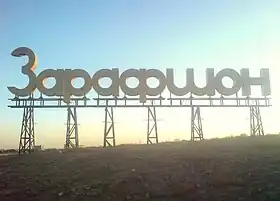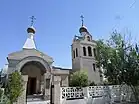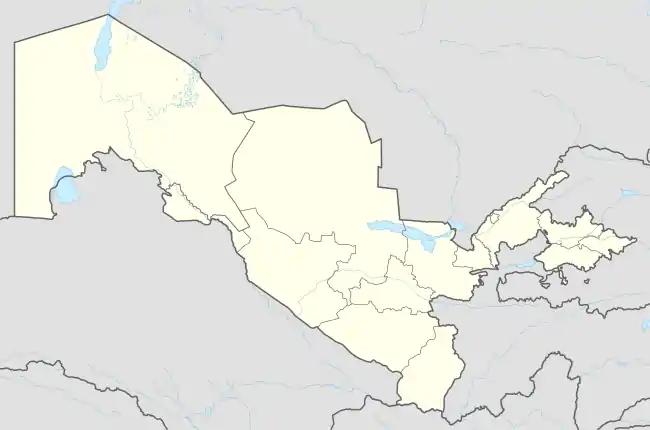Zarafshon
Zarafshon (Uzbek: Zarafshon / Зарафшон, Persian: زرافشان) is a city in the center of Uzbekistan's Navoiy Region. Administratively, it is a district-level city, that includes the urban-type settlement Muruntau.[2] It has an area of 20 km2 (7.7 sq mi)[3] and it has 85,100 inhabitants (2021). Located in the Kyzylkum desert, it receives water from the Amudarya by a 220-km pipeline.
Zarafshon
Zarafshon / Зарафшон | |
|---|---|
   Zarafshan | |
 Zarafshon Location in Uzbekistan | |
| Coordinates: 41°36′29″N 64°13′35″E | |
| Country | |
| Region | Navoiy Region |
| Area | |
| • Total | 20 km2 (8 sq mi) |
| Elevation | 400 m (1,300 ft) |
| Population (2021) | |
| • Total | 85,100 |
| • Density | 4,300/km2 (11,000/sq mi) |
Zarafshon is called "the gold capital of Uzbekistan". It is home of the Navoi Mining & Metallurgy Combinat's Central Mining Administration, charged with mining and processing gold from the nearby Muruntau open-pit mine. Between 1995 and 2006 the Muruntau gold mining and processing operation was run by the Zarafshan-Newmont Joint Venture, a foreign direct investment by Newmont Mining Corporation of Denver, Colorado (at the time the largest U.S. investor in Uzbekistan - it was also the first major Western investment in the region since the breakup of the Soviet Union). Uzbekistan expropriated the company's assets in 2006 and by 2007 had taken full ownership of the mine.
Zarafshan Airport (IATA: AFS) is served by Uzbekistan Airlines with direct daily flights to and from Tashkent.
History
Construction of the city began in the early 1960s and continued until the collapse of the USSR, 1965 is considered the official year of the city's foundation. On January 16, 1967, Zarafshon received the status of an urban-type settlement.[4] At the time of the collapse of the USSR, the city had 12 microdistricts with typical Soviet (3-, 4-, 5-, 7- and 9-story) buildings. There were 8 comprehensive schools and 21 kindergartens in the city.
Initially, the city was created for the residence of workers servicing industrial facilities for gold mining located at Muruntau Mine and «Bessopan» industrial site and being a part of Navoi Mining and Metallurgy Combinat. Gold production from the Muruntau Mine deposit accounted for approximately 30% of total gold production in the USSR.
During the Soviet period, the gold mine was being developed non-stop. Workers were recruited from all over the Soviet Union, and only a few left to return.
Zarafshon became the third industrial city in Navoiy region, after Uchquduq and Navoiy, built due to the establishment of city-forming enterprises (Navoi Mining and Metallurgical Combinat and Navoiyazot) in the region in the late 50s and early 60s.
The largest division of Navoi Mining and Metallurgical Combinat is located in the city of Zarafshon, it is the Central Mining Department, which currently includes 29 main and auxiliary divisions. The main task of the Central Mining Department is the development of precious metal deposits (gold, silver) and their mining.
References
- "Classification system of territorial units of the Republic of Uzbekistan" (in Uzbek and Russian). The State Committee of the Republic of Uzbekistan on statistics. July 2020.
- "Navoiy viloyatining ma'muriy-hududiy bo'linishi" [Administrative-territorial division of the Navoiy Region] (PDF) (in Uzbek). Navoiy regional department of statistics.
- Ведомости Верховного Совета СССР. № 6 (1352), 1967 г.
